- Joined
- Feb 4, 2021
- Messages
- 5,010
On traditional hitch cords (polyester covers) you’d look for glazing where the cord rubs the rope. A hardened cover, noticeable abrasion (not a few soft looking burs which are typical wear and tear, but rather deep cuts, strand loosening ect….) and the you’d check it for flat spots. The thumb and pointer finger bending test can tell you if the ropes core is flattened and damaged or not. On these newer high heat cords it’s much harder to tell if it’s compromised. Abrasion will look the same, but technora seems to not hold its shape as well as polyester or nylon so it flattens a little easier. Additionally since it doesn’t glaze, you aren’t concerned about it melting however it’s much harder to truly tell if the core was compromised either from flattening, heat or shock loading. They are great cords BUt like anything they have cons as well.Can I tag on a question here? Good, thanks.
What is the life expectancy of a fiction cord? Do you evaluate that by eye? All fuzzy and floppy is time to retire? Obviously hard or glazed spots are an issue to, but I've seen that people just retie the hitch to deal with that sort of issue?
Mostly curious. Hitch cord is cheap enough to buy plenty and toss it for new if there's any doubt whatsoever. Still good to know how to evaluate one that isn't obviously compromised
I say all that to basically say retire cords according to wear and tear. That will differ from amount of use and application. There is no set in stone length of service for hitch cord that I can find
Last edited:










